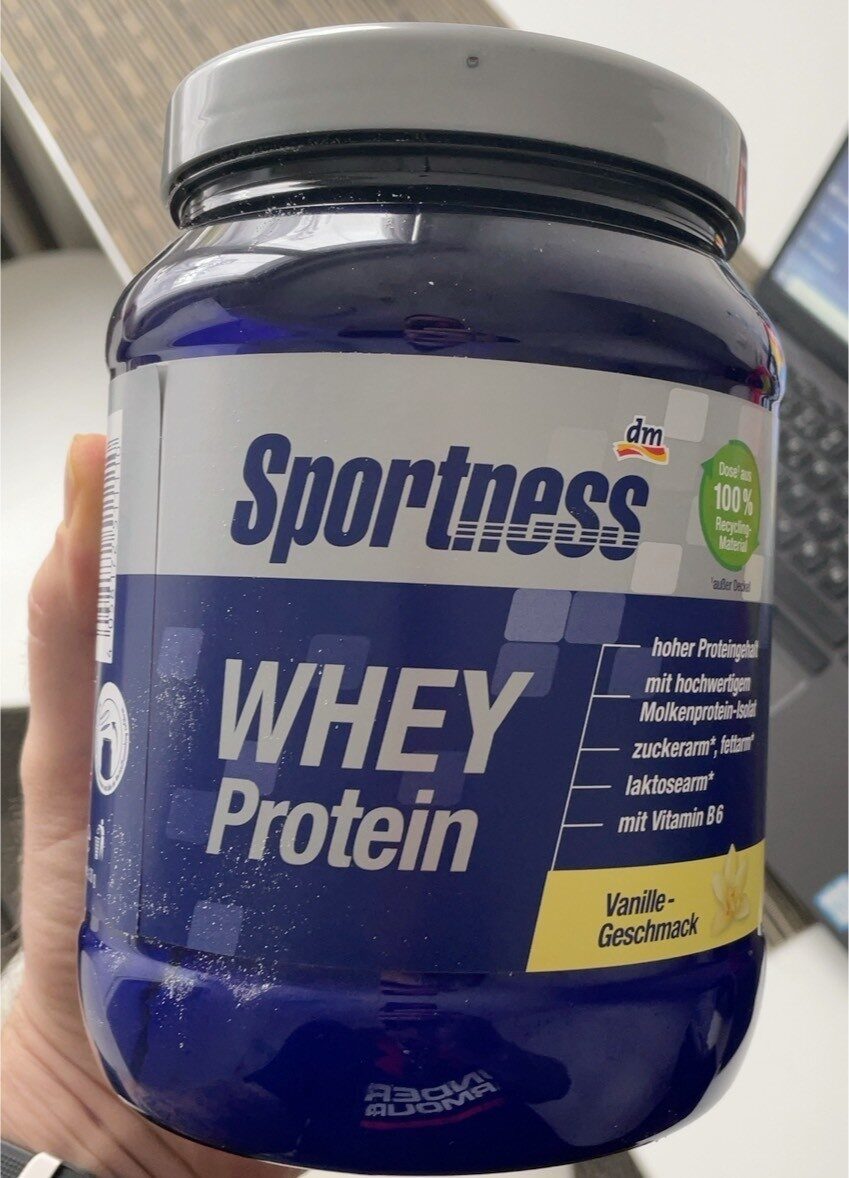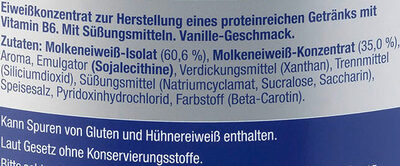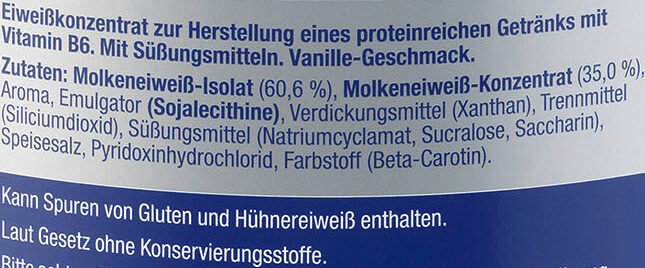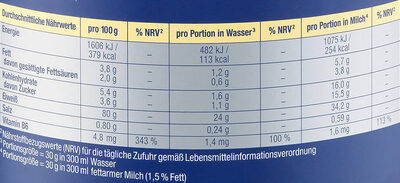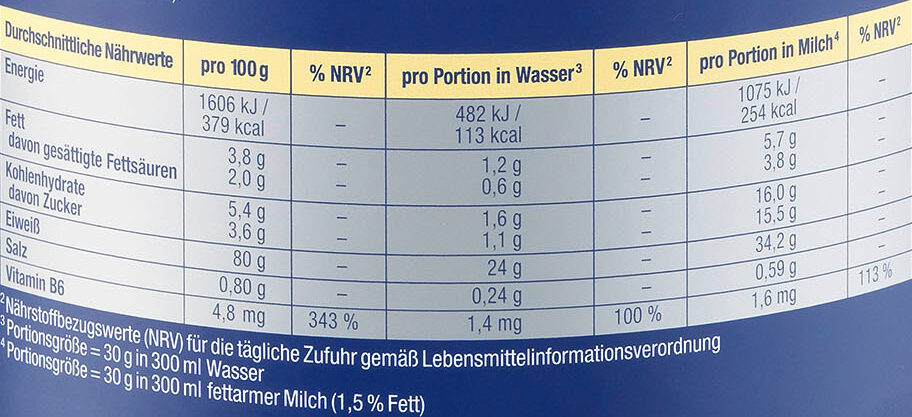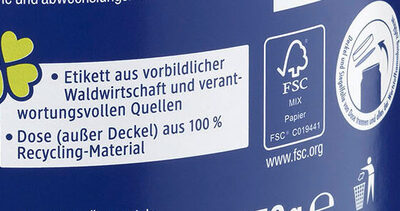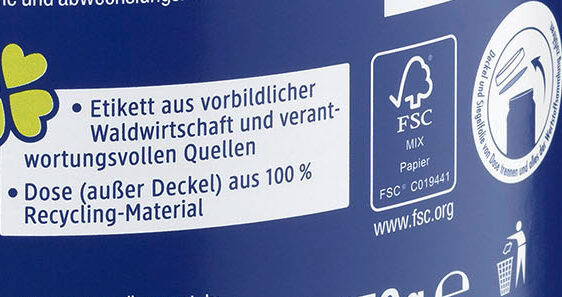Help us make food transparency the norm!
As a non-profit organization, we depend on your donations to continue informing consumers around the world about what they eat.
The food revolution starts with you!
Whey proteine - Sportness - 450 g
Whey proteine - Sportness - 450 g
Barcode: 4058172511110 (EAN / EAN-13)
Common name: Eiweißkonzentrat zur Herstellung eines proteinreichen Getränkes mit Vitamin B6. Vanille-Geschmack. Mit Zucker(n) und Süßungsmittel(n)
Quantity: 450 g
Packaging: Plastic, Paper, Can, Label, Lid
Categories: Dietary supplements, Bodybuilding supplements, Protein powders
Labels, certifications, awards:
Low or no fat, Low or no sugar, Low fat, No preservatives, Source of proteins, FSC, FSC Mix, High proteins, Made in Germany, Rich in vitamin B6
Origin of the product and/or its ingredients: Hergestellt in Deutschland. Molkeneiweiß-Isolat aus EU.
Origin of ingredients: European Union
Manufacturing or processing places: Deutschland
Traceability code: FSC-C019441
Link to the product page on the official site of the producer: https://www.dm.de/sportness-whey-protein...
Stores: Dm
Countries where sold: Germany
Matching with your preferences
Health
Ingredients
-
17 ingredients
: Molkeneiweiß-Isolat 60,6 %, Molkeneiweiß-Konzentrat 35,0 %, Aroma, Emulgator (Sojalecithine), Verdickungsmittel (Xanthan), Trennmittel (Siliciumdioxid), Süßungsmittel (Natriumcyclamat, Sucralose, Saccharin), Speisesalz, Pyridoxinhydrochlorid, Farbstoff (Beta-Carotin).Allergens: Milk, SoybeansTraces: Eggs, Gluten
Food processing
-
Ultra processed foods
Elements that indicate the product is in the 4 - Ultra processed food and drink products group:
- Additive: E160a - Carotene
- Additive: E415 - Xanthan gum
- Additive: E551 - Silicon dioxide
- Additive: E954 - Saccharin and its salts
- Additive: E955 - Sucralose
- Ingredient: Colour
- Ingredient: Emulsifier
- Ingredient: Flavouring
- Ingredient: Milk proteins
- Ingredient: Sweetener
- Ingredient: Thickener
Food products are classified into 4 groups according to their degree of processing:
- Unprocessed or minimally processed foods
- Processed culinary ingredients
- Processed foods
- Ultra processed foods
The determination of the group is based on the category of the product and on the ingredients it contains.
Additives
-
E160a - Carotene
Carotene: The term carotene -also carotin, from the Latin carota, "carrot"- is used for many related unsaturated hydrocarbon substances having the formula C40Hx, which are synthesized by plants but in general cannot be made by animals -with the exception of some aphids and spider mites which acquired the synthesizing genes from fungi-. Carotenes are photosynthetic pigments important for photosynthesis. Carotenes contain no oxygen atoms. They absorb ultraviolet, violet, and blue light and scatter orange or red light, and -in low concentrations- yellow light. Carotenes are responsible for the orange colour of the carrot, for which this class of chemicals is named, and for the colours of many other fruits, vegetables and fungi -for example, sweet potatoes, chanterelle and orange cantaloupe melon-. Carotenes are also responsible for the orange -but not all of the yellow- colours in dry foliage. They also -in lower concentrations- impart the yellow coloration to milk-fat and butter. Omnivorous animal species which are relatively poor converters of coloured dietary carotenoids to colourless retinoids have yellowed-coloured body fat, as a result of the carotenoid retention from the vegetable portion of their diet. The typical yellow-coloured fat of humans and chickens is a result of fat storage of carotenes from their diets. Carotenes contribute to photosynthesis by transmitting the light energy they absorb to chlorophyll. They also protect plant tissues by helping to absorb the energy from singlet oxygen, an excited form of the oxygen molecule O2 which is formed during photosynthesis. β-Carotene is composed of two retinyl groups, and is broken down in the mucosa of the human small intestine by β-carotene 15‚15'-monooxygenase to retinal, a form of vitamin A. β-Carotene can be stored in the liver and body fat and converted to retinal as needed, thus making it a form of vitamin A for humans and some other mammals. The carotenes α-carotene and γ-carotene, due to their single retinyl group -β-ionone ring-, also have some vitamin A activity -though less than β-carotene-, as does the xanthophyll carotenoid β-cryptoxanthin. All other carotenoids, including lycopene, have no beta-ring and thus no vitamin A activity -although they may have antioxidant activity and thus biological activity in other ways-. Animal species differ greatly in their ability to convert retinyl -beta-ionone- containing carotenoids to retinals. Carnivores in general are poor converters of dietary ionone-containing carotenoids. Pure carnivores such as ferrets lack β-carotene 15‚15'-monooxygenase and cannot convert any carotenoids to retinals at all -resulting in carotenes not being a form of vitamin A for this species-; while cats can convert a trace of β-carotene to retinol, although the amount is totally insufficient for meeting their daily retinol needs.Source: Wikipedia
-
E160ai - Beta-carotene
Beta-Carotene: β-Carotene is an organic, strongly colored red-orange pigment abundant in plants and fruits. It is a member of the carotenes, which are terpenoids -isoprenoids-, synthesized biochemically from eight isoprene units and thus having 40 carbons. Among the carotenes, β-carotene is distinguished by having beta-rings at both ends of the molecule. β-Carotene is biosynthesized from geranylgeranyl pyrophosphate.β-Carotene is the most common form of carotene in plants. When used as a food coloring, it has the E number E160a. The structure was deduced by Karrer et al. in 1930. In nature, β-carotene is a precursor -inactive form- to vitamin A via the action of beta-carotene 15‚15'-monooxygenase.Isolation of β-carotene from fruits abundant in carotenoids is commonly done using column chromatography. It can also be extracted from the beta-carotene rich algae, Dunaliella salina. The separation of β-carotene from the mixture of other carotenoids is based on the polarity of a compound. β-Carotene is a non-polar compound, so it is separated with a non-polar solvent such as hexane. Being highly conjugated, it is deeply colored, and as a hydrocarbon lacking functional groups, it is very lipophilic.Source: Wikipedia
-
E415 - Xanthan gum
Xanthan gum (E415) is a natural polysaccharide derived from fermented sugars, often used in the food industry as a thickening and stabilizing agent.
This versatile food additive enhances texture and prevents ingredient separation in a wide range of products, including salad dressings, sauces, and gluten-free baked goods.
It is considered safe for consumption even at high intake amounts.
-
E551 - Silicon dioxide
Silicon dioxide: Silicon dioxide, also known as silica, silicic acid or silicic acid anydride is an oxide of silicon with the chemical formula SiO2, most commonly found in nature as quartz and in various living organisms. In many parts of the world, silica is the major constituent of sand. Silica is one of the most complex and most abundant families of materials, existing as a compound of several minerals and as synthetic product. Notable examples include fused quartz, fumed silica, silica gel, and aerogels. It is used in structural materials, microelectronics -as an electrical insulator-, and as components in the food and pharmaceutical industries. Inhaling finely divided crystalline silica is toxic and can lead to severe inflammation of the lung tissue, silicosis, bronchitis, lung cancer, and systemic autoimmune diseases, such as lupus and rheumatoid arthritis. Uptake of amorphous silicon dioxide, in high doses, leads to non-permanent short-term inflammation, where all effects heal.Source: Wikipedia
-
E954 - Saccharin and its salts
Saccharin: Sodium saccharin -benzoic sulfimide- is an artificial sweetener with effectively no food energy. It is about 300–400 times as sweet as sucrose but has a bitter or metallic aftertaste, especially at high concentrations. Saccharin is used to sweeten products such as drinks, candies, cookies, and medicines.Source: Wikipedia
-
E955 - Sucralose
Sucralose: Sucralose is an artificial sweetener and sugar substitute. The majority of ingested sucralose is not broken down by the body, so it is noncaloric. In the European Union, it is also known under the E number E955. It is produced by chlorination of sucrose. Sucralose is about 320 to 1‚000 times sweeter than sucrose, three times as sweet as both aspartame and acesulfame potassium, and twice as sweet as sodium saccharin. Evidence of benefit is lacking for long-term weight loss with some data supporting weight gain and heart disease risks.It is stable under heat and over a broad range of pH conditions. Therefore, it can be used in baking or in products that require a long shelf life. The commercial success of sucralose-based products stems from its favorable comparison to other low-calorie sweeteners in terms of taste, stability, and safety. Common brand names of sucralose-based sweeteners are Splenda, Zerocal, Sukrana, SucraPlus, Candys, Cukren, and Nevella. Canderel Yellow also contains sucralose, but the original Canderel and Green Canderel do not.Source: Wikipedia
Ingredients analysis
-
May contain palm oil
Ingredients that may contain palm oil: E160ai
-
Non-vegan
Non-vegan ingredients: Whey protein isolate, Whey protein
-
Maybe vegetarian
Ingredients that may not be vegetarian: Flavouring, E160ai
-
Details of the analysis of the ingredients
: Molkeneiweiß-Isolat 60.6%, Molkeneiweiß 35%, Aroma, Emulgator (Sojalecithine), Verdickungsmittel (Xanthan), Trennmittel (Siliciumdioxid), Süßungsmittel (Natriumcyclamat, Sucralose, Saccharin), Speisesalz, Pyridoxinhydrochlorid, Farbstoff (Beta-Carotin)- Molkeneiweiß-Isolat -> en:whey-protein-isolate - vegan: no - vegetarian: yes - percent_min: 60.6 - percent: 60.6 - percent_max: 60.6
- Molkeneiweiß -> en:whey-protein - vegan: no - vegetarian: yes - percent_min: 35 - percent: 35 - percent_max: 35
- Aroma -> en:flavouring - vegan: maybe - vegetarian: maybe - percent_min: 0.550000000000001 - percent_max: 4.40000000000001
- Emulgator -> en:emulsifier - percent_min: 0 - percent_max: 2.2
- Sojalecithine -> en:soya-lecithin - vegan: yes - vegetarian: yes - ciqual_food_code: 42200 - percent_min: 0 - percent_max: 2.2
- Verdickungsmittel -> en:thickener - percent_min: 0 - percent_max: 1.46666666666667
- Xanthan -> en:e415 - vegan: yes - vegetarian: yes - percent_min: 0 - percent_max: 1.46666666666667
- Trennmittel -> en:anti-caking-agent - percent_min: 0 - percent_max: 1.1
- Siliciumdioxid -> en:e551 - vegan: yes - vegetarian: yes - percent_min: 0 - percent_max: 1.1
- Süßungsmittel -> en:sweetener - percent_min: 0 - percent_max: 0.880000000000002
- Natriumcyclamat -> en:e952 - vegan: yes - vegetarian: yes - percent_min: 0 - percent_max: 0.880000000000002
- Sucralose -> en:e955 - vegan: yes - vegetarian: yes - percent_min: 0 - percent_max: 0.440000000000001
- Saccharin -> en:e954 - vegan: yes - vegetarian: yes - ciqual_food_code: 31064 - percent_min: 0 - percent_max: 0.293333333333334
- Speisesalz -> en:salt - vegan: yes - vegetarian: yes - ciqual_food_code: 11058 - percent_min: 0 - percent_max: 0.8
- Pyridoxinhydrochlorid -> en:pyridoxine-hydrochloride - vegan: yes - vegetarian: yes - percent_min: 0 - percent_max: 0.62857142857143
- Farbstoff -> en:colour - percent_min: 0 - percent_max: 0.62857142857143
- Beta-Carotin -> en:e160ai - vegan: maybe - vegetarian: maybe - from_palm_oil: maybe - percent_min: 0 - percent_max: 0.62857142857143
- Molkeneiweiß-Isolat aus EU.
Molkeneiweiß-Isolat -> en:whey-protein-isolate
Nutrition
-
Average nutritional quality
⚠ ️Warning: the amount of fiber is not specified, their possible positive contribution to the grade could not be taken into account.⚠ ️Warning: the amount of fruits, vegetables and nuts is not specified on the label, it was estimated from the list of ingredients: 0This product is not considered a beverage for the calculation of the Nutri-Score.
Positive points: 5
- Proteins: 5 / 5 (value: 80, rounded value: 80)
- Fiber: 0 / 5 (value: 0, rounded value: 0)
- Fruits, vegetables, nuts, and colza/walnut/olive oils: 0 / 5 (value: 0, rounded value: 0)
Negative points: 8
- Energy: 4 / 10 (value: 1606, rounded value: 1606)
- Sugars: 0 / 10 (value: 3.6, rounded value: 3.6)
- Saturated fat: 1 / 10 (value: 2, rounded value: 2)
- Sodium: 3 / 10 (value: 320, rounded value: 320)
The points for proteins are counted because the negative points are less than 11.
Nutritional score: (8 - 5)
Nutri-Score:
-
Nutrient levels
-
Fat in moderate quantity (3.8%)
What you need to know- A high consumption of fat, especially saturated fats, can raise cholesterol, which increases the risk of heart diseases.
Recommendation: Limit the consumption of fat and saturated fat- Choose products with lower fat and saturated fat content.
-
Saturated fat in moderate quantity (2%)
What you need to know- A high consumption of fat, especially saturated fats, can raise cholesterol, which increases the risk of heart diseases.
Recommendation: Limit the consumption of fat and saturated fat- Choose products with lower fat and saturated fat content.
-
Sugars in low quantity (3.6%)
What you need to know- A high consumption of sugar can cause weight gain and tooth decay. It also augments the risk of type 2 diabetes and cardio-vascular diseases.
Recommendation: Limit the consumption of sugar and sugary drinks- Sugary drinks (such as sodas, fruit beverages, and fruit juices and nectars) should be limited as much as possible (no more than 1 glass a day).
- Choose products with lower sugar content and reduce the consumption of products with added sugars.
-
Salt in moderate quantity (0.8%)
What you need to know- A high consumption of salt (or sodium) can cause raised blood pressure, which can increase the risk of heart disease and stroke.
- Many people who have high blood pressure do not know it, as there are often no symptoms.
- Most people consume too much salt (on average 9 to 12 grams per day), around twice the recommended maximum level of intake.
Recommendation: Limit the consumption of salt and salted food- Reduce the quantity of salt used when cooking, and don't salt again at the table.
- Limit the consumption of salty snacks and choose products with lower salt content.
-
-
Nutrition facts
Nutrition facts As sold
for 100 g / 100 mlPrepared
per serving (30 g + 300 ml fettarmer Milch 1,5%)Compared to: Protein powders Energy 1,606 kj
(379 kcal)1,075 kj
(254 kcal)+6% Fat 3.8 g 5.7 g -12% Saturated fat 2 g 3.8 g +13% Carbohydrates 5.4 g 16 g -32% Sugars 3.6 g 15.5 g +12% Fiber ? ? Proteins 80 g 34.2 g +14% Salt 0.8 g 0.59 g -1% Vitamin B3/PP (Niacin) 4.8 mg 1.6 mg -65% Fruits‚ vegetables‚ nuts and rapeseed‚ walnut and olive oils (estimate from ingredients list analysis) 0 % ? L-Valin 4.94 g ? L-Serin 3.81 g ? L-Glycin 1.41 g ? L-Threonin 5.62 g ? L-Phenylalanin 2.56 g ? L-Isoleucin 5.22 g ? L-Histidin 1.31 g ? L-Leucin 8.62 g ? L-Tyrosin 2.34 g ? L-Lysin 7.26 g ? L-Alanin 4.02 g ? L-Arginin 2.17 g ? L-Prolin 4.03 g ? L-Methionin 1.74 g ? L-Tryptophan 1.25 g ? L-Asparaginsäure 8.42 g ? L-Glutaminsäure 13.41 g ? L-Cystein 1.88 g ?
Environment
-
Eco-Score not computed - Unknown environmental impact
We could not compute the Eco-Score of this product as it is missing some data, could you help complete it?Could you add a precise product category so that we can compute the Eco-Score? Add a category
Packaging
-
Packaging with a medium impact
-
Packaging parts
Label (Plastic)
Lid (Paper)
Can (Metal)
-
Packaging materials
Material % Packaging weight Packaging weight per 100 g of product Paper or cardboard Plastic Metal Total
-
Transportation
-
Origins of ingredients
Origins of ingredients with a high impact
Origin of the product and/or its ingredients % of ingredients Impact European Union 100 %High
Report a problem
-
Incomplete or incorrect information?
Category, labels, ingredients, allergens, nutritional information, photos etc.
If the information does not match the information on the packaging, please complete or correct it. Open Food Facts is a collaborative database, and every contribution is useful for all.
Data sources
Product added on by openfoodfacts-contributors
Last edit of product page on by thekumi.
Product page also edited by c0dekr4ft, kiliweb, packbot, roboto-app, worldtest, xalibur, yuka.sY2b0xO6T85zoF3NwEKvlnFsCNr1uQr6MULhnBSo5tCAcsD0Yo1r34fhGKo.

